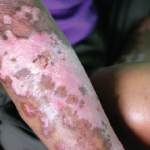Polypharmacologic therapy describes the simultaneously inhibition of several targets with one drug. Nintedanib, a multiple tyrosine kinase inhibitor, is an example for this approach because it targets several profibrotic pathways.24 Nintedanib is in a Phase 3 clinical trial for treatment of SSc-related ILD now.
“Multityrosine kinase inhibitors inhibit a broader spectrum of targeted molecules, and this may provide additional efficacy, but may also be associated with a higher possibility of adverse events,” says Dr. Distler. The heterogeneity of SSc is one challenge for the development of more effective therapies.
“The pathologic pathways may be different in different subsets of patients. That leads to problems in predicting response to treatment,” says Dr. Distler. “We need to better understand the different pathways that lead to different phenotypes in these patients. Progress has been made in this effort, but our classification of different phenotypes is not fine enough yet. We don’t fully understand the pathogenesis of this disease. We have so much more to do.”
Susan Bernstein is a freelance medical journalist based in Atlanta.
References
- Helmick CG, Felson DT, Lawrence RC, et al. Estimates of the prevalence of arthritis and other rheumatic conditions in the United States. Arthritis Rheum. 2008 Jan;58(1):15–25.
- Wynn TA. Cellular and molecular mechanisms of fibrosis. J Pathol. 2008 Jan;214(2):199–210.
- Hernandez-Rodriguez NA, Cambrey AD, Harrison NK, et al. Role of thrombin in pulmonary fibrosis. Lancet. 1995 Oct 21;346 (8982):1071–1073.
- Rouzaud-Laborde C, Delmas C, Pizzinat N, et al. Platelet activation and arterial peripheral serotonin turnover in cardiac remodeling associated to aortic stenosis. Am J Hematol. 2015 Jan;90(1):15–19.
- Tu X, Chen X, Xie Y, et al. Anti-inflammatory renoprotective effect of clopidogrel and irbesartan in chronic renal injury. J Am Soc Nephrol. 2008 Jan;19(1):77–83.
- Dees C, Akhmetshina A, Zerr P, et al. Platelet-derived serotonin links vascular disease and tissue fibrosis. J Exp Med. 2011 May;208(5):961–972.
- Ebrahimkhani MR, Oakley F, Murphy LB, et al. Stimulating healthy tissue regeneration by targeting the 5-HT2B receptor in chronic liver disease. Nat Med. 2011 Nov;17(12):1668–1673.
- Farina G, Lafyatis D, Lemaire R, et al. A four-gene biomarker predicts skin disease in patients with diffuse cutaneous systemic sclerosis. Arthritis Rheum. 2010 Feb;62(2):580–588.
- Nurden AT. Platelets, inflammation, and tissue regeneration. Thromb Haemost. 2011 May;105 Suppl 1:S13–S33.
- Rice LM, Padilla CM, McLaughlin SR, et al. Fresolimumab treatment decreases biomarkers and improves clinical symptoms in systemic sclerosis patients. J Clin Invest. 2015 Jun;125(7):2795–2807.
- Lacouture ME, Morris JC, Lawrence DP, et al. Cutaneous keratoacanthomas/squamous cell carcinomas associated with neutralization of transforming growth factor β by the monoclonal antibody fresolimumab (GC1008). Cancer Immunol Immunother. 2015 Apr;64(4):437–446.
- Bogatkevich GS, Ludwicka-Bradley A, Silver RM. Dagibatran, a direct thrombin inhibitor, demonstrates antifibrotic effects on lung fibroblasts. Arthritis Rheum. 2009 Nov;60(11):3455–3464.
- Johnson SR, Granton JT, Tomlinson GA, et al. Effect of warfarin on survival in scleroderma-associated pulmonary arterial hypertension (SSc-PAH) and idiopathic PAH: Belief elicitation for Bayesian priors. J Rheumatol. 2011 March;38(3):462–469.
- Arnson Y, Amital H, Agmon-Levin N, et al. Serum 25-OH vitamin D concentrations are linked with various clinical aspects in patients with systemic sclerosis: A retrospective cohort study and review of the literature. Autoimmun Rev. 2011 Jun;10(8):490–494.
- Zerr P, Vollath S, Palumbo-Zerr K, et al. Vitamin D receptor regulates TGFβ signaling in systemic sclerosis. Ann Rheum Dis. 2015 Mar;74(3):e20.
- Ding N, Yu RT, Subramaniam N, et al. A vitamin D receptor/SMAD genomic circuit gates hepatic fibrotic response. Cell. 2013 Apr;153(3):601–613.
- Wohlfahrt T, Usherenko S, Englbrecht M, et al. Type 2 innate lymphoid cell counts are increased in patients with systemic sclerosis and correlate with the extent of fibrosis. Ann Rheum Dis. 2016 Mar;75(3):623–626.
- Feghali CA, Bost KL, Boulware DW, et al. Mechanisms of pathogenesis in scleroderma. I. Overproduction of interleukin 6 by fibroblasts cultured from affected skin sites of patients with scleroderma. J Rheumatol. 1992 Aug;19(8):1207–1211.
- Koch AE, Kronfeld-Harrington LB, Szekanecz Z, et al. In situ expression of cytokines and cellular adhesion molecules in the skin of patients with systemic sclerosis. Their role in early and late disease. Pathobiology. 1993;61(5-6):239–246.
- Distler O, Distler JH. Tocilizumab for systemic sclerosis: Implications for future trials. Lancet. 2016 Jun;387(10038):2580–2581.
- Jordan S, Distler JH, Maurer B, et al. Effects and safety of rituximab in systemic sclerosis: An analysis form the European Scleroderma Trial and Research (EUSTAR) group. Ann Rheum Dis. 2015 Jun;74(6):1188–1194.
- Wei J, Ghosh AK, Sargent JL, et al. PPARγ downregulation by TGFβ in fibroblast and impaired expression and function in systemic sclerosis: A novel mechanism for progressive fibrogenesis. PLoS One. 2010 Nov;5(11):e13778.
- Ruzehaji N, Frantz C, Ponsoye M, et al. Pan PPAR agonist IVA337 is effective in prevention and treatment of experimental skin fibrosis. Ann Rheum Dis. 2016 Dec;75(12):2175–2183.
- Huang J, Beyer C, Palumbo-Zerr K, et al. Nintendanib inhibits fibroblast activation and ameliorates fibrosis in preclinical models of systemic sclerosis. Ann Rheum Dis. 2016 May;75(5):883–890.

